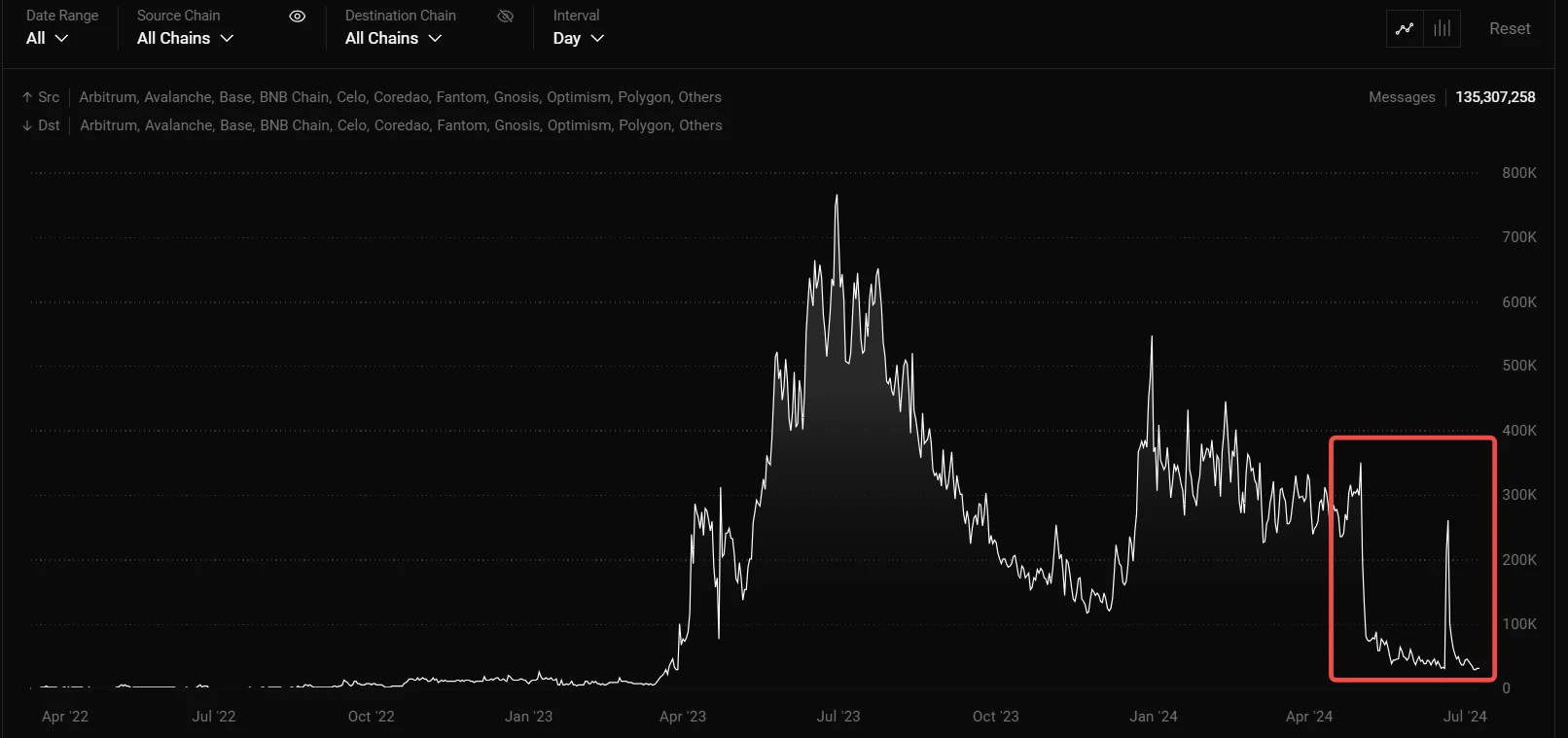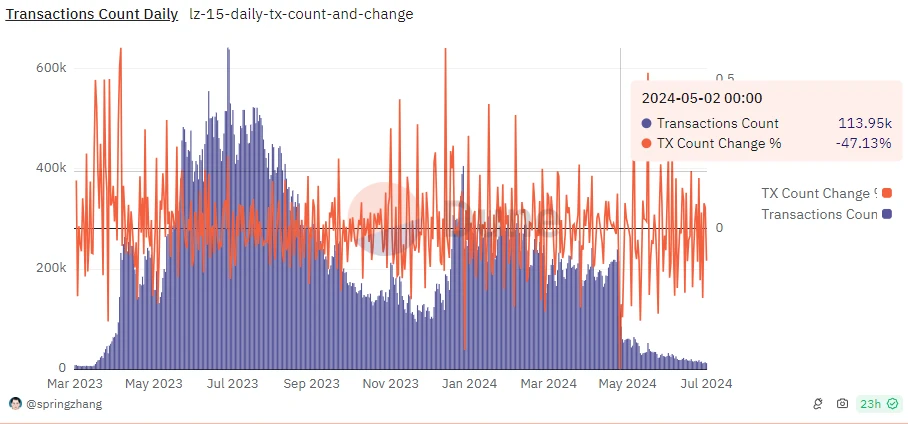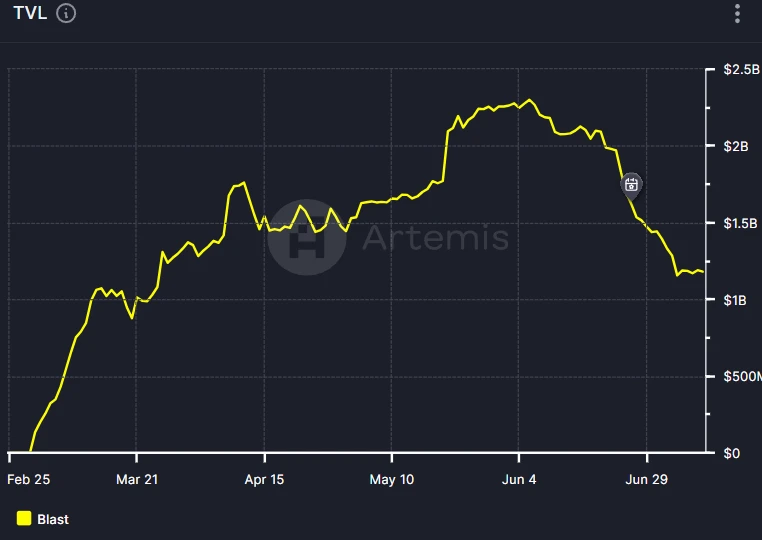Original | Odaily Planet Daily ( @OdailyChina )
Author: Golem ( @web3_golem )

The four most popular airdrop projects in the first half of 2024 (Starknet, ZKsync, LayerZero, Blast) finally came to an end after the airdrop. However, there are still frequent disputes about their actual network status on social media. Some people believe that their once dazzling on-chain data is due to the existence of furious users and studios, and when the airdrop is completed, they will be a ghost town on the chain with only 8 real users.
So what is the real situation? How many users will remain after the excitement is over? Now is the time to see their true strength. In this article, Odaily Planet Daily will compare and summarize these 4 projects from the perspectives of on-chain active addresses, TVL, transaction volume and other data.
Starknet: There is a lot of user loss, but the network quality has not declined significantly
The airdrop period for Starknet’s official token STRK is from February 20 to June 20.
The number of active addresses has decreased by about 80% compared to before the airdrop
In order to sell as soon as possible and avoid selling pressure, many users will choose to receive airdrops as early as possible. Therefore, according to data from the official Starknet browser starkscan, on February 21, the number of daily active addresses on the Starknet network was close to the historical high in July 2023, exceeding 380,000 addresses.

However, after most users received the airdrop, the number of daily active addresses also dropped sharply. After June 20, the number of daily active addresses had dropped to the level of March 2023, about 15,000 to 20,000.
From May 2023 to February 2024, before the airdrop was announced, the average number of daily active addresses on the Starknet network was about 100,000. However, after the airdrop was completed, the number of daily active addresses has decreased by about 80%.
TVL: U-standard decreased after the airdrop, but coin-standard did not decrease
According to the data from the official Starknet browser starkscan, overall, the TVL of the Starknet network is still on an upward trend. Calculated in terms of currency, the amount of ETH locked has been increasing. Even after the STRK airdrop, the TVL did not drop much. The decline in STRKs TVL in April in the figure was due to the plunge in the currency price, while the actual total amount of locked STRK did not change much.

There is no significant change in daily trading volume, and the number of transactions has decreased
According to Defillama data, the daily transaction volume of the Starknet network did not change significantly before and after the airdrop, and the airdrop did not affect users enthusiasm for trading on the Starknet network.

However, the number of daily transactions has dropped precipitously. According to Artemis data, the number of daily transactions on the Starknet network hit a new high on February 20, the day of the airdrop, but has since generally been on a downward trend, far below the level before the airdrop.

summary
The above data generally reflects that due to the end of the airdrop, the number of active users and studios have withdrawn, the number of network active users and transaction frequency has decreased, but the overall network quality has not decreased too much. The network TVL and daily transaction volume are not much different before and after the airdrop. At the same time, the impact of the decline in the number of overall transactions is that the networks handling fees and income also decreased after the airdrop.

ZKsync: The highest proportion of real users and better network quality
The airdrop of ZKsync’s official token ZK will start on June 17th.
The number of active addresses has decreased by about 40% compared to before the airdrop
According to the Dune dashboard created by Matter Labs, the number of daily active addresses of ZKsync hit a record high on the day of the airdrop. After most users claimed their tokens, the number of daily active addresses dropped by about 70% compared to the day of the airdrop, but only dropped by about 40% compared to before the airdrop.

TVL: U-base decreased, but airdrops did not have much impact
According to Artemis data, the TVL of the ZKsync Era network, calculated in U-base terms, had already shown a downward trend before the airdrop began in March of this year, and the TVL continued to decline after the airdrop in June.

However, according to the data from L2 beat, the TVL of the ZKsync Era network after the airdrop is not significantly down, calculated in terms of currency. It can be seen that the reduction in TVL is not greatly affected by the airdrop, but may be more affected by other factors (such as the overall track market, currency prices, ecological construction, etc.).

There is no significant change in daily trading volume before and after the airdrop
According to Defillama data, due to the demand for airdrops, the ZKsync Era network transaction volume reached 240 million US dollars on June 17, setting a record high in 2024. However, after the airdrops were received, the daily transaction volume quickly returned to the average level, and there was no obvious decline.

However, similar to the number of daily active addresses, the number of daily transactions on the ZKsync Era network reached a record high of about 1.7 million on the day of the airdrop on June 16. The number of daily transactions then fell, decreasing by about 50% compared to the average daily transaction number before the airdrop.

summary
The above data generally reflects that the proportion of real users in the ZKsync Era network is relatively high. The number of users and transaction frequency only decreased by 40% to 50% before and after the airdrop. Other aspects of network quality were less affected by the changes before and after the airdrop.
LayerZero: The largest user loss and a sharp drop in network quality
LayerZero announced a snapshot in early May and officially opened airdrop applications on June 20.
The number of daily active addresses has decreased by about 85% compared to before the snapshot was announced.
According to Dune data, since LayerZero announced the completion of the snapshot in early May, the number of active addresses on the chain has dropped precipitously. Before May 2, the number of active addresses on the chain was over 110,000. After May 2, it directly decreased by about 40%, and then gradually reached a new low, a decrease of more than 85% compared to before the snapshot was announced.

Cross-chain messages have been reduced by about 80% compared to before the airdrop
According to data from LayerZeros official browser layerzeroscan, the total number of messages using LayerZero cross-chain also experienced a cliff-like drop after the official announcement of the snapshot. Except for the improvement in data on the day of the airdrop on June 20, the average data decreased by more than 80% compared to before the airdrop, returning to the level of March 2023.

Cross-chain amount and daily transaction volume reduced by more than 90%
According to Dune data, daily funds using LayerZero for cross-chain transactions plummeted after the official snapshot announcement, remaining at an average of around US$15 million per day, a decrease of more than 90% compared to the peak before the airdrop.

At the same time, the number of daily transactions using LayerZero also fell by about 47% on the day the snapshot was announced. The average number of daily transactions after the airdrop remained at around 20,000, which was a decrease of more than 90% compared to the average daily transaction number of 200,000 before the airdrop.

summary
The above data reflects that the performance of the LayerZero network is not objective. There is a big difference between the data before and after the airdrop. The user and network quality have dropped by about 90% compared with before the airdrop. This also proves that when the freeloaders and studios withdraw, the actual user demand of LayerZero is only 1/10 of that before the airdrop.
Blast: Lack of user confidence and worrying future development
Blast will distribute the airdrop a week after the announcement on February 20, and the airdrop of the official token BLAST will start on June 26.
Daily active addresses continue to decline
According to Artemis data, the number of daily active addresses of Blast was on an upward trend in June, indicating that users confidence in Blast was actually increasing. However, when the airdrop landed on June 26, the number of daily active addresses dropped sharply, returning to the level of March in just a few days, and this downward trend is still continuing.

TVL started to fall before the airdrop
According to Artemis data, the TVL of the Blast network had already begun to show a downward trend when its official announcement of the upcoming airdrop was made on June 20. After the airdrop on June 26, the downward trend became even more obvious, and funds were being withdrawn from Blast.

There is no significant change in daily trading volume, and the number of daily transactions has dropped sharply
According to data from Defillama, the transaction volume of the Blast network showed an upward trend in June, reaching an all-time high on June 26 due to airdrops, but quickly returned to the average level in June before the airdrop.

The number of daily transactions is similar to the number of daily active addresses. It began to decline after Blast officially announced the airdrop on June 20. It rebounded briefly because Blasts decentralized leveraged trading protocol Particle opened airdrops to users on July 2, but it is still on a downward trend overall.

summary
The above data shows that although the first phase of Blast airdrop has not been over for long, users confidence in Blast is obviously insufficient, and both users and funds have shown obvious signs of withdrawal compared with before the airdrop. However, it can also be seen from the transaction volume that due to the construction of ecological applications and the new phase of airdrop incentives, the network quality is still in a good state.
Conclusion
In summary, we can see that before the airdrop, these four projects did have a lot of water in terms of user volume and on-chain activity. However , with the withdrawal of a large number of freeloaders and studios after the airdrop, the real on-chain data was restored, and all projects returned to their own value. Then, we can more objectively see who is swimming naked.
Regarding the two Ethereum L2s (Starknet and ZKsync ) that follow a technical narrative, after the airdrop, from the perspective of the actual number of users and network quality, they are not as bad as imagined, and the TVL and transaction volume are not proportional to the decrease in the number of active addresses.
On the contrary, the data of cross-chain interoperability protocol LayerZero and income-based L2 Blast before and after the airdrop are quite different. In particular, LayerZero not only saw a sharp drop in active addresses on the chain, but also a sharp drop in daily cross-chain amounts. This also indirectly shows that when the airdrop bubble bursts, the true value of the cross-chain protocol needs to be further evaluated.
Of course, the current data cannot represent their performance. With the development of mainstream narratives, market changes, and the progress of project roadmaps, the market will choose truly valuable projects in the future and eliminate those projects that rely on airdrop points strategies to gain temporary popularity.
After all, when the airdrop is over, the real fight begins.










